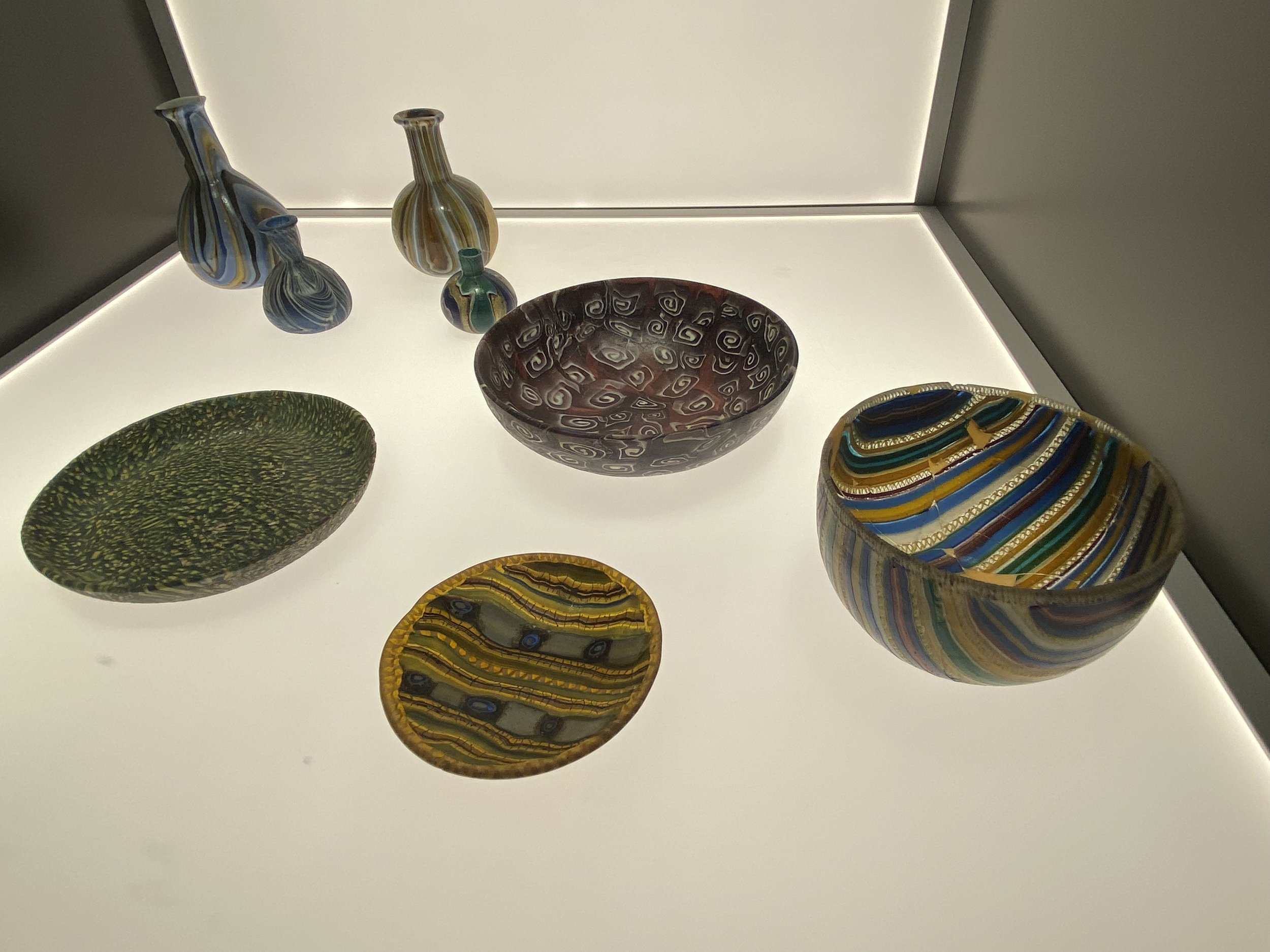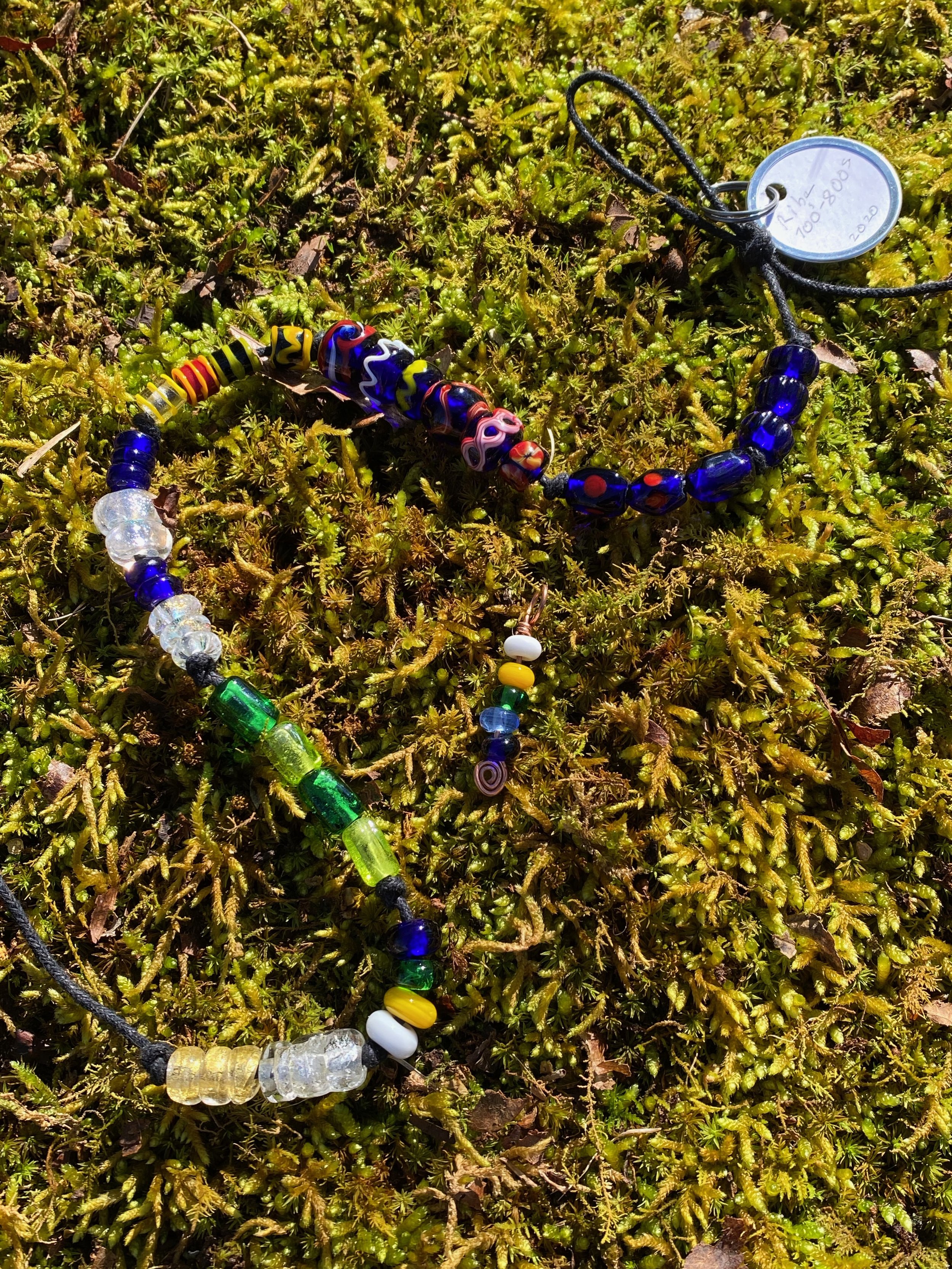Norse Glass Beads Production, Chronology and Geography
From Furnace to Flame: Presentation
Lykania
My interest in Norse beads had its roots in my boredom during the start of the pandemic. I was already experimenting with glass but had not developed my talents with glasswork. Tomas Ribsoms book, The Bead Maker from Ribe, provided me with inspiration and the pandemic provided me with the time.
Beads from The Bead Maker from Ribe with a copy of the book.
I started by working on the beads from Ribsom’s book, then expanded my work to Denmark and the wider Norse world. And well, it got out of control from there…
5000 Years: A History of Glass 3000 BCE to the 476 CE
Obsidian Arrow Head (Reproduction)
Early humans were taking advantage of natural glass, such as obsidian, to make tools by 3000 BCE and by 1560-1530 BCE they were creating obsidian vessels. Around 2000 BCE, the first man-made glass was made in Mesopotamia (Later in parts of Egypt and Asia). Between 1550 -1200 BCE people had developed techniques for working Faience (a glass like substance) and Soft Glass. By the end of this period complex core-formed glass vessels were in production.
Core Formed Vessels (CMOG)
The Iron Age introduced new materials for making glass working tools. By this time complex mosaic glass was being produced. as well as most of the techniques needed to make the classic Norse bead. The Romans introduced the blow pipe in the 1st Century, which allowed for the production of utilitarian glass and for complex blown glass pieces. The rise of glass production on an industrial scale created a substantial amount of glass material that would later be worked by the Norse.
Roman Mosaic Work (Marano Glass Museum )
Roman Glass (Olympia)
After the “Fall of Rome”, the glass trade network contracted; however, a new forest glass industry was taking root among the Franks while the Mediterranean industry persisted. Meanwhile, the people in the North Atlantic region were left with remnants of Roman glass; scrap, tessera, and arelume beads. Arelume beads were left behind by previous cultures, such as Roman Mosaic Beads. During the Norse/Viking Age glass, new beads made using the Wrapped or the drawn-and-cut method. The Drawn-and-cut beads were mass-produced in glass blowing shops by cutting hollow cane.
Reproduction of A Roman Mosaic Beads (not made by me)
Wrapped beads are made by wrapping soft glass around a mandrel coated in bead release. The release allows the bead to break away from the mandrel once the bead has cooled. These types of beads represent the method used to make the classic monochromatic and polychromatic beads associated with the Norse.
This bead was made using the wrapped method. The bead is incomplete allowing the artifact of the warping to be seen.
Drawn-and-cut beads are made by creating a gather on a blow pipe and blowing a bubble into the gather, then pulling the glass into a whole cane. The cane is then broken into bead-sized segments and worked cold to finish the ends.
My first Drawn and Cut Beads
Whether the bead is made with the wrapped or drawn-and-cut method, the glass has its origin in a furnace were Soda Lime and Ash come together to form glass.
Glass Melt at Hands on Glass in Corning New York USA.
This glass can be colored and shaped into materials for future production or into a final product. Glass is given is color by adding metal oxides to the glass or by mixing previously colored crushed glass into new combinations.
Cane from clear glass colored with Copper Foil.
Frit made of crushed color can be used to color clear glass.
Glass can be formed in to chunks or ingots, crushed, or pulled into Bars, Rods, Canes, and Stringers. All of which can be re-worked to decorate a glass object or to form wrapped beads.
Cobolt Ingot of Glass and Beads made from it.
Glass color in the form of Rods, Cullet, Rods, and the beads made from them.
There was enough glass left over from Roman glass production and the Forest Glass industry to supply Norse glass workers, who then made wrapped beads over a small, controlled heat source. This type of glass work is called Flame-worked (Lamp-worked). And the wrapped beads was the common method for making these beads.
The Beads
Types
There are some basic categories that can be applied to the beads found at places like Ribe. Drawn and Cut beads and Wrapped beads are one way to categorize them.
Monocromatic beads feature just one color.
Polychromatic Beads feature two ore more colors.
Beads can also be categorized by design characteristics. Both monochromatic and polychromatic beads can be categorized on size and shape of the the bead.
Seed/Spacers, small narrow beads.
Cones/Bi-cones
Faceted
Segmented
Basic, donut and spherical beads.
Barrel/Cylinder
Melon
Sculpted
Polychromatic beads can be categorized by the decorations applied to them.
Dots, Bumps, and Eyes
Wasp, Yellow decorations with lines and some times dots.
Feathered
S-Types, curves, and curved lines
Reticulated/Cable/Snake
Heart of ____
These beads have a liner and out layer the heart is the inner layer.
Crumb/Confettii
Scrollwork
Folded/Twisted
Ribbon, “Mexico Stripes”
Frankenstein
Foil
The Chronology
My first look into the chronology of beads at Ribe was based on the the article by Claus Feveile and Stig Jensen, “Ribe in the 8th and 9th Century: A Contribution to the Archaeological Chronology of the North Western Europe,” Acta Archaeologica, Vol. 71 (2000): 22-24. I used the diagram in the article and the description to make the beads.
These beads are strung in the chronological order of the Post Office Dig.
Matthew Delvaux’s chronology can help put the beads found at Ribe into a broader regional context. He describes 6 phases in this chronology: Phase 1 (660-700), Phase 2 (700-760), Phase 3 (760-790), Phase 4 (790-820), Phase 5 (820-860), and Phase 6 (860-890).
Consuming Beads: A Tentative Chronology of the Viking Age
This chronology lines up well with the post office dig. I have found it to broadly apply in the Norse, Anglo, and Frankish area and thereby, useful for the creation of original collections of bead strands that seem to fit the times.
Phase 1 (660-700)
Phase 2 (700-725)
Phase 2 (725-760)
Phase 2 (725-760)
As the Norse world reconnected with Mediterranean and the Silk Road trade networks, glass fell off as a trade commodity, and gave way to hack silver and coin silver. Meanwhile, the market was flooded with mass produced Drawn and Cut beads from the Mediterranean.
Phase 3 (760-790)
Phase 4 (790-820)
During Phase 5 (820-860)
Beads from the last period returned to the classic look but without the quality.
During Phase 6 (860-900)
Color
In order to understand the color palette of Norse beads I pulled from my experience with reproducing individual beads and the works of Matthew C. Delvaux.
“Colors of the Viking Age”
Among other insights, Delvaux produced a percentage breakdown of colors in Norse beads from Hedeby. Pictured above are 100 beads with colors distrubuted by Delvaux’s percentages.
Location
I have collected many of my reproduction strands in a portfolio. They are loosely grouped by time and location.
Birka
Finland
Iceland
Use
Glass beads served key roles in three aspects of Norse life. They were used as trade goods, for decoration, and in funeral rights. There were differences in use based on age, status, gender/sex, and religion as well as the afore mentioned variation over time and location.
Working Glass and Making The Beads
My Furnace
I learned the basics of glass blowing and built a small hot shop in order to work glass into the constituent parts that go into the making of Norse glass beads. My goal was to make a variety of color rods that could be used to make beads with glass that I colored myself. I made both monochromatic rods and polychromatic reticulated cane, ribbons, and even mosaic cane.
Glass I colored and pulled by hand
Most of the colored glass I created was made by mixing crushed glass called frit to achieve the desired color. However, I did make a good amount of turquoise glass using copper foil.
Beads made from glass colored with gold foil
Before exploring the larger industry, I had focused primarily on how to make the beads. At this point, the focus was on the construction of the bead but using my modern tools and torch. Over time my research shifted to more authentic tools and heat sources.
Here a Wrapped Beads is being formed using a modern Hot Head Style Torch.
The first step is to make a base bead on a mandrel using the heat from a torch or focused flame. That bead can then be decorated with glass or metal foils, and shaped with a variety of tools made from brass, iron, and stone.
Foil
Modern and Period Marvers
Finally, the decorated and shaped bead is flame polished and then cooled slowly to prevent thermal shock. The vast majority of the beads I made were annealed (cooled) in a modern computer controlled kiln. Some were annealed using the flame the bead was made on to cool it or the heat from the charcoal stove.
Finishing a bead over the torch.
Annealing beads to prevent thermal shock.
Once I was comfortable with how to make the beads with modern quality-controlled materials and precision equipment, I transitioned to using more traditional tools and experimenting with a variety of glass sources, from scrap stained glass and recycled bottles to Italian tessera.
Tessera from Murano
Scrap Glass Beads
Beads Made from Tessera
At first when I was making faceted beads, I was putting the facets in hot. The historical finds though often appeared to be worked cold, so I decided to try my hand at Lapeworking to make some of my beads in to cut faceted beads.
Hot worked facets
Lapeorking a bead
I have worked fused glass bowls by hand with sand paper to polish, but for these beads I used a modern lapidary set.
Cut Bead
Pulling It All Together
Beads Made on Modern Torch.
Beads made of glass I colored by had and worked on the modern torch.
Thomas Ribosom describes how the Norse at Ribe used clay stoves to work glass. Some refer to these as bead furnaces, although I use the word stove to differentiate them from the furnaces used by glass blowers.
Hybrid Stove that I made It is mobile and uses a fan to aspirate.
Tron Tee’s Stove aspirated with dual bellows.
Gallery Flói’s naturally Aspirated Stove.
The evidience at Ribe indicates the stoves were naturally aspirated; however, other researchers suggested manual aspirated stoves. I experimented with a few wood burning stoves for making beads and met with a glass artist Gallery Flói in Iceland, who also works with such stoves. The stove I built uses a fan to simulate bellows in order to allow me to work solo. It took a few tries to refine the techniques for making the classic Ribe bead using charcoal as a heat source. I was able to make beads from COE: , 104, and 96. The COE and 104 glass was manufactured glass rods. The COE 96 was from glass rods that had been colored and pulled by me. I also was able to use glass tessera from Murano Italy to make beads. It is significantly easier to make smaller beads this way.
Unannealed beads made on Iron Tree’s Stove
Beads made on the Stove With no annealer
These are links to related Blogs and Videos.
It took several attempts to be able to pull it all together, but my efforts were rewarded in the end.
Final product from my hybrid stove
Beyond the Norse
Reproduction of Woman’s Dress and Necklace at the 1238 Museum
The story of glass continues beyond the Norse/Viking Age. These reproductions of glass items from after the Viking Age are displayed at the Battle of 1238 Museum, in Iceland. They reflect the continuing development of glasswork and the influence of Norse glass and our continued fascination with the story of pre-modern glass. Glass lives on in the North Atlantic countries, both in the work of the glassworkers who live and work there today and by inspiring other across the globe.
Glass Goblet Reproduction
Glass Goblet Reproduction
My Work Continues
My recent visit to Iceland gave me the opportunity to see Viking Age Glass in person at some of their museums. I continue to work to expand my understanding. Every piece of glass I see informs me, and every piece I make refines my understanding. This is a work in progress.
Beads in the National Museum of Iceland
Thank You
Editing and Preparation: Trish, Heather, and Becky.
Patrons: Laura Terhune, Brian Bottoms, Leslie Hodgin, Ellen Rawson, DeAnna Gilbert, Alison Petrisek, Christine Seelye-King, Brianna Ariane Sykes, Laura Gosnell, Janice Gaulke and Molly Tobin.
One way to support my work is with this Go Fund Me.











































































